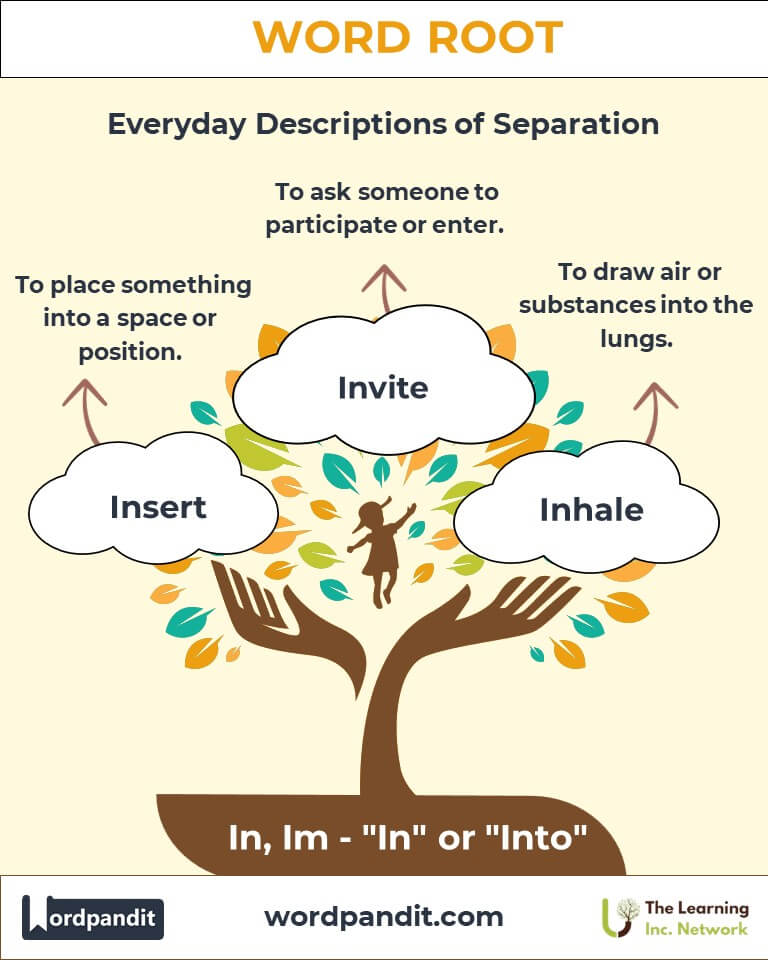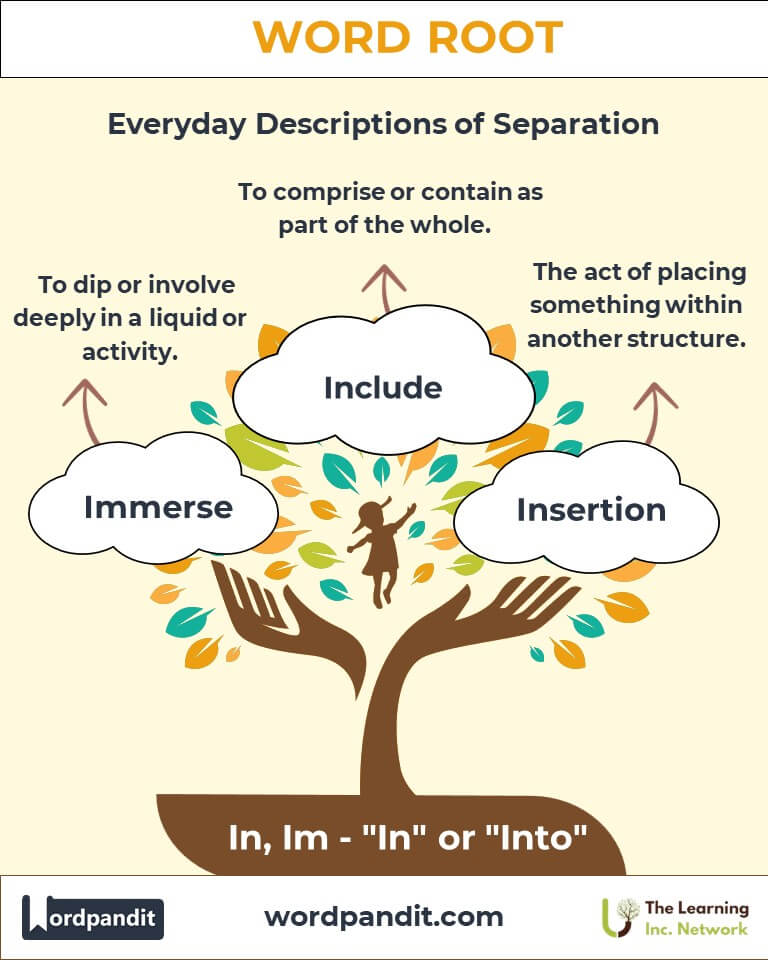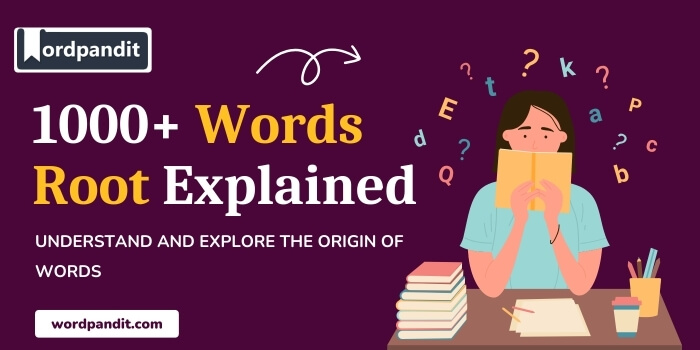In, Im: The Root of Entry and Immersion in Language
Byline: Explore the significance of the roots "in" and "im," derived from Latin, meaning "in" or "into." These versatile prefixes enrich the English language by forming words that signify entry, inclusion, or immersion, like "insert" and "immerse." Dive into their etymology, applications, and cultural relevance across fields and time.

Table of Contents
- Introduction: The Essence of In and Im
- Etymology and Historical Journey
- Mnemonic: Unlocking the Power of In and Im
- Common In and Im-Related Terms
- In and Im Through Time
- In and Im in Specialized Fields
- Illustrative Story: In and Im in Action
- Cultural Significance of In and Im
- The In and Im Family Tree
- FAQs about the In and Im Roots
- Test Your Knowledge: In and Im Mastery Quiz
- Conclusion: The Everlasting Legacy of In and Im
Introduction: The Essence of In and Im
The roots "in" and "im," pronounced as /in/ or /im/, represent the idea of movement or placement "into" something. Derived from Latin, these prefixes have shaped numerous words in English, signaling inclusion, immersion, or entry. From the practical act of inserting a key to the profound experience of immersing oneself in a novel, "in" and "im" resonate across contexts and disciplines.

Etymology and Historical Journey
The roots "in" and "im" originate from the Latin preposition in, meaning "in" or "into." As Latin evolved and influenced other languages, these prefixes merged with root words to indicate motion toward or within something. For example:
- Insert: (to put into) developed as a fusion of in and serere (to join or attach).
- Immerse: (to dip into) combined in with mergere (to plunge).
Over time, the flexibility of "in" and "im" allowed them to form words that describe both physical and abstract actions.
Mnemonic: Unlocking the Power of In and Im
Imagine stepping into a cozy, warm house during a snowstorm, feeling the safety and comfort of being "inside." This vivid imagery encapsulates the essence of "in" and "im"—movement toward a place or state.
Mnemonic Device: "In means into—immerse yourself, insert the key, and invite the change."
Common In and Im-Related Terms
- Insert (in-SERT): To place something into a space or position.
Example: "He inserted the coin into the vending machine to buy a snack." - Immerse (im-MURSE): To dip or involve deeply in a liquid or activity.
Example: "She immersed herself in the book, losing track of time." - Include (in-KLOOD): To comprise or contain as part of the whole.
Example: "The price includes taxes and service fees." - Invite (in-VITE): To ask someone to participate or enter.
Example: "They invited their neighbors to the garden party." - Inhale (in-HALE): To draw air or substances into the lungs.
Example: "He inhaled deeply to steady his nerves before the presentation."
In and Im Through Time
- Early Usage: Initially described physical placement, such as inserting a peg into a hole.
- Modern Context: Now commonly used for data entry or digital actions, like inserting a USB device.
- Historic Context: Originally referred to baptism by immersion in water.
- Expanded Use: Now extends to intellectual or emotional engagement, such as immersing oneself in learning.
In and Im in Specialized Fields
- Medicine:
- Inhalation: Refers to the act of breathing in medication or gases for treatment.
- Example: "The doctor recommended an inhaler for asthma relief."
- Technology:
- Insertion Point: The blinking cursor in digital text fields, signifying where text will appear.
- Example: "Click to move the insertion point in the document."
- Education:
- Immersive Learning: A teaching method that places students directly into real-life scenarios or simulations.
- Example: "The language program uses immersive techniques for faster fluency."
- Hospitality:
- Invitation Protocols: Formal systems for welcoming guests.
- Example: "The hotel sent out digital invites for its grand reopening."
Illustrative Story: In and Im in Action
Lila, a passionate educator, created an immersive virtual reality experience to teach history. As students inserted themselves into ancient Roman streets, they inhaled the scents of simulated marketplaces and interacted with virtual citizens. The program’s success stemmed from its ability to invite students into the past, making history more tangible and engaging.
Cultural Significance of In and Im
The prefixes "in" and "im" symbolize inclusion and connection in culture and society. Whether it's inviting someone to a celebration or immersing oneself in a new culture, these roots highlight the importance of participation and engagement. They also appear in idiomatic expressions like "in the loop," underscoring the value of being informed and involved.

The In and Im Family Tree
Related Prefixes:
- En- (French origin): Meaning "in" or "within."
- Example: Encircle (to surround).
- Inter- (Latin origin): Meaning "between."
- Example: Interact (to engage between entities).
- Intro- (Latin origin): Meaning "within" or "inward."
- Example: Introduce (to bring into knowledge or experience).

FAQs About the In and Im Roots
Q: What do "in" and "im" mean?
A: The prefixes "in" and "im" mean "in" or "into," signifying movement toward or placement within something. For example:
- Insert means to put something into a space or position.
- Immerse refers to being deeply involved or physically placed into a medium (like water or an activity).
They reflect actions of inclusion or internalization.
Q: Why do we use "im" instead of "in" in some words?
A: The prefix "im" is a variation of "in" that appears before words starting with "m" or "p." This change, called assimilation, makes pronunciation smoother. For instance:
- Immerse is easier to pronounce than "inmerse."
- Similarly, import (to bring in goods) uses "im" for the same reason.
Q: Are there exceptions to these prefixes meaning "in"?
A: Yes, in some cases, "in" and "im" mean "not" instead of "into." This happens when these prefixes are used as negatives, such as:
- Impossible: Not possible.
- Incapable: Not capable.
The meaning depends on the context and the root word they modify.
Q: What is an insertion point?
A: An insertion point is the blinking cursor in a digital document or text field. It shows where text will appear when typed. This term is commonly used in technology, especially in word processing software.
Q: How do "in" and "im" enrich English?
A: These prefixes form versatile words that describe inclusion, immersion, or movement into something, enriching language across various fields:
- In medicine: Inhalation refers to drawing air into the lungs.
- In technology: Insert is used for adding elements into documents or systems.
- In education: Immersive methods create hands-on experiences that deepen learning.
Q: Why do "in" and "im" prefixes symbolize connection?
A: "In" and "im" often convey inclusion, suggesting a sense of belonging or being part of something. Words like invite (to ask someone to join) and include (to make part of a whole) emphasize connection and participation, reflecting the roots' central meaning.
Q: What is immersive learning?
A: Immersive learning refers to educational methods where participants are deeply involved in simulated or real-life scenarios. For example, virtual reality environments allow students to "enter" historical settings, creating an engaging and impactful experience.
Test Your Knowledge: In and Im Mastery Quiz
1. What does the root "in/im" signify?
2. Which word means "to breathe in"?
3. Why is "im" used in immerse?
4. What does immersive learning involve?
5. Which field uses "inhalation" extensively?
Conclusion: The Everlasting Legacy of In and Im
The roots "in" and "im" enrich language by describing acts of inclusion and immersion, both physically and metaphorically. From inserting a key to immersing oneself in culture, these prefixes remind us of the power of connection and entry. Their continued relevance highlights the timeless nature of entering and engaging with the world around us.












